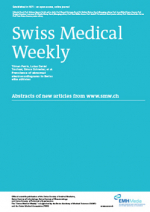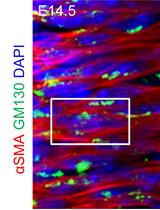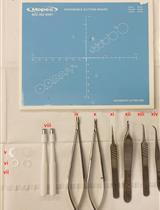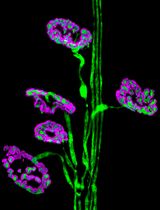- EN - English
- CN - 中文
The Chick Chorioallantoic Membrane (CAM) Assay as a Three-dimensional Model to Study Autophagy in Cancer Cells
以鸡胚绒毛尿囊膜(CAM)为三维模型研究癌细胞自噬作用
发布: 2019年07月05日第9卷第13期 DOI: 10.21769/BioProtoc.3290 浏览次数: 10648
评审: Yifan Wangilgen MenderAnonymous reviewer(s)
Abstract
The chick chorioallantoic membrane (CAM) is an extra-embryonic organ and thus well accessible for seeding and harvesting 3D cell cultures. Samples from CAM assays are suitable for protein and gene expression analysis as well as for immuno-histochemical studies. Here we present the CAM assay as a possible model to study autophagy in different types of cancer using immunohistochemistry. Compared with other 3D and xenograft models, the CAM assay displays several advantages such as lower costs, shorter experimental times, physiological environment and reproducibility. Macroautophagy hereafter simply referred to as “autophagy” is a conserved cellular catabolic process that degrades and recycles cellular components. Under basal conditions, autophagy contributes to the maintenance of cellular homeostasis whereas under cellular stress, such as starvation or hypoxia, autophagy is activated as a survival mechanism. Dysregulation of autophagy has been described in many diseases. In cancer, autophagy has been suggested to play a dual role. Whereas autophagy has been reported to play a tumor suppressive role in early stages, it seems to be rather tumor supportive in later stages. Here we provide a method to study autophagy in 3D microtumors of cancer cells grown on the CAM.
Keywords: CAM (CAM)Background
The chick chorioallantoic membrane (CAM) is a highly vascularized extra-embryonic membrane that has multiple functions during embryonic development, such as gas exchange (Romanoff, 1960). It is a well-known model to study blood vessels and angiogenesis in the context of tumor biology (Kain et al., 2014; Nowak-Sliwinska et al., 2014). The chick development in the egg lasts 21 days (Romanoff, 1960). Three days after starting incubating the eggs, we cut a small round window into the eggshell for easy access to the CAM later in the procedure (Figure 1). At this time point the membrane is not yet formed and thus there is no risk to damage it. On Day 7 of embryo development the tumor cells are seeded on the CAM and seven days later (Day 14) the microtumors that developed on the membrane are harvested and analyzed. To this end, the tumors are excised, fixed, dehydrated, embedded and cut to apply immunohistochemical stainings for the autophagy-related markers: microtubule associated protein 1 light chain 3 beta (MAP1LC3B, short LC3B) and sequestosome 1 (SQSTM1, aka p62).
Experimentally assessing autophagy is challenging, since it is a dynamic process, and steady state expression levels of autophagy related genes do not give a complete picture of the active autophagic process (Barth et al., 2010). In tissue, dot like staining of LC3B and p62 is considered a better indication of autophagic flux, defined as the degradation rate of cargo via autophagy (Martinet et al., 2013). Our group previously established an automated LC3B and p62 staining and scoring protocol for tumor tissue (Schläfli et al., 2015), which we apply here on microtumors generated in the CAM model. Using a 3D CAM xenograft model to broaden our knowledge on autophagy in tumor biology has several advantages. It is easy accessible for manipulation (addition of an autophagy blocking agent), for microscopy (for instance to analyze the growth and vascularization of the tumors) and it provides small tumors that are suitable for immunohistochemical analyses. Thus, the expression of different markers can be visualized in the tissue.
Figure 1. Overview of the workflow. The development of the chicken in the egg takes in total 21 days. At Day 3 of incubation, when the CAM is not yet formed a window is cut into the eggshell. At Day 7 of incubation when the membrane is visible but not yet completely developed the cancer cells are seeded in a collagen scaffold and then transferred to the membrane. After another 7 days in the incubator, at Day 14 of development the tumor is harvested, fixed and embedded.
Materials and Reagents
- Egg trays
- Nitrile gloves (ecoSHIELD, ecoshieldTM eco nitrile PF 250, catalog number: 62512X)
- Syringe 5 ml (Codan)
- Needle (BC MicrolanceTM 3, 18 G)
- Adhesive tape (MagicTM tape, invisible, 7.5 mm, Scotch, 8-1975R2)
- Collagen sponge (AviteneTM UltrafoamTM, BARD, catalog number: 1050050)
- Petri dish 10 cm (TC dish 100, standard) (Sarstedt, catalog number: 83.3902)
- Tube 50 ml (Sarstedt, catalog number: 62.547.254)
- Pipettes
- Tissue embedding sponges (Kartell, catalog number: 02922-04)
- Embedding cassette (Sakura, Tissue-Tek® Uni-Cassette®, Biopsy Grey, catalog number: 4172)
- Plastic containers
- Fertilized Ross 308 broiler eggs (Wüthrich Geflügel AG, Belp, Schweiz)
- OE19 esophageal adenocarcinoma cells (ECACC, catalog number: 96071721)
- Antibody (Dako, M7240)
- Antibody (Novus Biologicals, NB600-1384)
- Antibody (MBL rabbit polyclonal, LabForce, Nunningen, Switzerland, #PM0045)
- RPMI-1640 (Sigma-Aldrich, Acuderm inc., catalog number: R8758)
- Fetal bovine serum (Sigma-Aldrich, catalog number: F7524)
- VPS34 inhibitor (VPS34-IN1, Selleckchem, catalog number: 1382716-33-3)
- Accutase (StemProTM, Thermo Fisher, catalog number: A1110501)
- Acetic acid (glacial, 100%) (Merck, catalog number: 100063)
- Chloroform for analysis (Merck, catalog number: 102445)
- Formalin (Thommen-Furler, catalog number: 612103)
- Paraffin wax (Tissue-Tec®, Sakura, catalog number: 4656)
- Methanol for analysis (Merck, catalog number: 106009)
- Ethanol absolute (Merck, catalog number: 107017)
- Xylene (Sigma, catalog number: 16446)
- Mayer’s hemalum solution (Merck, catalog number: 109249)
- Eosin yellowish (Gurr, catalog number: 34197) (for working solution see Recipes)
- Phloxin B (Gurr, catalog number: 43064)
- DAB detection kit (Venta Roche)
- Polymer refine detection kit (Leica, Biosystems, catalog number: DS9800)
- Carnoy’s fixative (see Recipes)
- Eosin-phloxin working solution (see Recipes)
- HER2 IHC (see Recipes)
- Ki76 IHC (see Recipes)
- LC3B IHC (see Recipes)
- P62/SQSTM1 IHC (see Recipes)
Equipment
- Operating scissors (14 cm, sharp, straight) (World Precision Instruments, catalog number: 501218-G)
- Tweezers
- Biopsy punch,8 mm (Acu-Punch, catalog number: P850)
- Humidified incubator with rotating drawers (Rcom, Maru 300 MAX)
- Humidified incubator stationary (Rcom, Maru hatcher & brooder 100)
- Laminar flow hood (Kojair®, BioWizard Silver SL-130 Blue Series)
- Water bath (GFL 1013, GFL_20007)
- Stereo microscope (OLYMPUS, SZX16)
- Oven (Binder, ED56)
- Benchmark Ultra immunostainer (Venta Roche)
- Leica Bond RX immunostainer (Leica Biosystems, Muttenz, Switzerland)
Software
- Olympus CellSens Standard 1.15 (OLYMPUS CORPORATION, www.olympus-sis.com)
Procedure
文章信息
版权信息
© 2019 The Authors; exclusive licensee Bio-protocol LLC.
如何引用
Janser, F. A., Ney, P., Pinto, M. T., Langer, R. and Tschan, M. P. (2019). The Chick Chorioallantoic Membrane (CAM) Assay as a Three-dimensional Model to Study Autophagy in Cancer Cells. Bio-protocol 9(13): e3290. DOI: 10.21769/BioProtoc.3290.
分类
细胞生物学 > 组织分析 > 组织染色
癌症生物学 > 瘤形成 > 体内组织培养模型
您对这篇实验方法有问题吗?
在此处发布您的问题,我们将邀请本文作者来回答。同时,我们会将您的问题发布到Bio-protocol Exchange,以便寻求社区成员的帮助。
Share
Bluesky
X
Copy link













